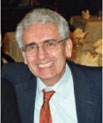Dendrimers: Order, Complexity, Functions
Vincenzo Balzani AA ‘G. Ciamician’ Department of Chemistry, University of Bologna, Italy.Email: vincenzo.balzani@unibo.it

Vincenzo Balzani is a Professor of Chemistry at the University of Bologna, Italy. He has received several scientific awards, including the Doctorate ‘Honoris Causa’ at the University of Fribourg (CH), Honor Professor at the East China University of Science and Technology, Italgas Prize for Research and Innovation, Porter Medal in Photochemistry, and Blaise Pascal Medal for Chemistry. He is a Fellow of the American Association for the Advancement of Science and the Accademia dei Lincei, and a member of the Editorial Board of several scientific journals. His has published more than 550 papers and five books, one of which (Molecular Devices and Machines, Wiley-VCH), written with A. Credi and M. Venturi, has been translated in Chinese and Japanese. He has delivered numerous lectures around the world. He is ranked among the most cited chemists, with an H index 76. His main research interests concern photochemistry, supramolecular chemistry, molecular devices and machines, and he is also deeply interested in the energy issue. His most recent book (Energy for a Sustainable World, Wiley-VCH), written with N. Armaroli, will be published in December 2010. |
Australian Journal of Chemistry 64(2) 129-130 https://doi.org/10.1071/CH10351
Published: 15 February 2011
Dendrimers are macromolecules that exhibit a defined structure and a high degree of order, but also a high degree of complexity. From a topological viewpoint, dendrimers contain three different regions: core, branches, and surface (Fig. 1a). A most important feature of dendrimer chemistry is the possibility to insert selected chemical units in predetermined sites of their architecture (Fig. 1b) and/or in internal cavities (Fig. 1c). Research in this field began in 1978 with Vögtle’s synthesis of cascade molecules, but has expanded only recently when the outstanding possibilities offered by dendrimer chemistry to construct novel photo- and redox-active species was fully realized. Dendrimers were initially developed in the field of organic chemistry, but several dendrimers based on, or containing metal ions have then been prepared and investigated. The study of metal-containing dendrimers has considerably expanded the scope of coordination chemistry.
Like trees, dendrimers exhibit aesthetically pleasant structure, but as in the case of a tree the interest in a specific dendrimer does not depend on its beauty, but on the fruit (i.e. the specific function) that it is able to produce. By using dendrimers it is possible to construct large molecules capable of performing complex functionalities that derive from the integration of the specific properties of the constituent units. Dendrimers are, indeed, ideal scaffolds to organize many photo- and/or redox-active units in a restricted space, according to predetermined patterns.
Depending on the specific composition and structure of a dendrimer, its functional units, as well as the species hosted in the dendritic cavities or associated to the dendrimer surface, can interact or behave independently. Interactions are much easier and particularly important after light excitation, resulting in energy and electron transfer processes and the formation of transient species like excimers and exciplexes.
In the field of electrochemistry, interesting results that can be obtained with dendrimers include the shielding of inner electroactive units by non-electroactive branches, the exchange of a great number of electrons in a very narrow potential range when several non interacting units of the same type are present, and the tailor-made redox patterns that can be obtained by dendrimers based on metal complexes at each branching centre. Applications include sensing, multi-electron transfer catalysis, and the construction of molecular batteries.
Dendrimers containing luminescent units are particularly interesting since luminescence signals offer a handle to better understand the dendritic structures and can be exploited to investigate a variety of photophysical processes such as multiple luminescence, down-conversion and up-conversion of the incident light, energy and electron transfer, light harvesting, quenching and sensitization. Some of these processes can be exploited for important applications such as sensing with signal amplification and sunlight harvesting in artificial photosynthetic systems.
Because of these and other not fully investigated properties (e.g. fluorescence at the single molecule level, non-linear optics) we can expect that the study on photo- and redox-active dendrimers will become the object of increasing interest in the next few years, both at the level of fundamental research as well as with the aim of designing technological applications for energy conversion and information processing.



